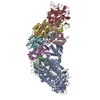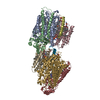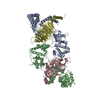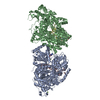+ Open data
Open data
- Basic information
Basic information
| Entry | Database: EMDB / ID: EMD-9655 | |||||||||
|---|---|---|---|---|---|---|---|---|---|---|
| Title | Cryo-EM structure of type III-A Csm complex | |||||||||
 Map data Map data | type III-A CRISPR-Cas interference complex, Csm | |||||||||
 Sample Sample |
| |||||||||
| Biological species |  Streptococcus thermophilus ND03 (bacteria) Streptococcus thermophilus ND03 (bacteria) | |||||||||
| Method | single particle reconstruction / cryo EM / Resolution: 3.8 Å | |||||||||
 Authors Authors | You L / Ma J / Wang J / Zhang X / Wang Y | |||||||||
 Citation Citation |  Journal: Cell / Year: 2019 Journal: Cell / Year: 2019Title: Structure Studies of the CRISPR-Csm Complex Reveal Mechanism of Co-transcriptional Interference. Authors: Lilan You / Jun Ma / Jiuyu Wang / Daria Artamonova / Min Wang / Liang Liu / Hua Xiang / Konstantin Severinov / Xinzheng Zhang / Yanli Wang /   Abstract: Csm, a type III-A CRISPR-Cas interference complex, is a CRISPR RNA (crRNA)-guided RNase that also possesses target RNA-dependent DNase and cyclic oligoadenylate (cOA) synthetase activities. However, ...Csm, a type III-A CRISPR-Cas interference complex, is a CRISPR RNA (crRNA)-guided RNase that also possesses target RNA-dependent DNase and cyclic oligoadenylate (cOA) synthetase activities. However, the structural features allowing target RNA-binding-dependent activation of DNA cleavage and cOA generation remain unknown. Here, we report the structure of Csm in complex with crRNA together with structures of cognate or non-cognate target RNA bound Csm complexes. We show that depending on complementarity with the 5' tag of crRNA, the 3' anti-tag region of target RNA binds at two distinct sites of the Csm complex. Importantly, the interaction between the non-complementary anti-tag region of cognate target RNA and Csm1 induces a conformational change at the Csm1 subunit that allosterically activates DNA cleavage and cOA generation. Together, our structural studies provide crucial insights into the mechanistic processes required for crRNA-meditated sequence-specific RNA cleavage, RNA target-dependent non-specific DNA cleavage, and cOA generation. | |||||||||
| History |
|
- Structure visualization
Structure visualization
| Movie |
 Movie viewer Movie viewer |
|---|---|
| Structure viewer | EM map:  SurfView SurfView Molmil Molmil Jmol/JSmol Jmol/JSmol |
| Supplemental images |
- Downloads & links
Downloads & links
-EMDB archive
| Map data |  emd_9655.map.gz emd_9655.map.gz | 28.5 MB |  EMDB map data format EMDB map data format | |
|---|---|---|---|---|
| Header (meta data) |  emd-9655-v30.xml emd-9655-v30.xml emd-9655.xml emd-9655.xml | 9.3 KB 9.3 KB | Display Display |  EMDB header EMDB header |
| Images |  emd_9655.png emd_9655.png | 64.9 KB | ||
| Archive directory |  http://ftp.pdbj.org/pub/emdb/structures/EMD-9655 http://ftp.pdbj.org/pub/emdb/structures/EMD-9655 ftp://ftp.pdbj.org/pub/emdb/structures/EMD-9655 ftp://ftp.pdbj.org/pub/emdb/structures/EMD-9655 | HTTPS FTP |
-Validation report
| Summary document |  emd_9655_validation.pdf.gz emd_9655_validation.pdf.gz | 79.2 KB | Display |  EMDB validaton report EMDB validaton report |
|---|---|---|---|---|
| Full document |  emd_9655_full_validation.pdf.gz emd_9655_full_validation.pdf.gz | 78.3 KB | Display | |
| Data in XML |  emd_9655_validation.xml.gz emd_9655_validation.xml.gz | 494 B | Display | |
| Arichive directory |  https://ftp.pdbj.org/pub/emdb/validation_reports/EMD-9655 https://ftp.pdbj.org/pub/emdb/validation_reports/EMD-9655 ftp://ftp.pdbj.org/pub/emdb/validation_reports/EMD-9655 ftp://ftp.pdbj.org/pub/emdb/validation_reports/EMD-9655 | HTTPS FTP |
-Related structure data
| Related structure data |  9653C  9654C  9656C  9657C  9658C  9659C  9660C  6ifkC  6iflC  6ifnC  6ifrC  6ifuC  6ifyC  6ifzC  6ig0C C: citing same article ( |
|---|---|
| Similar structure data |
- Links
Links
| EMDB pages |  EMDB (EBI/PDBe) / EMDB (EBI/PDBe) /  EMDataResource EMDataResource |
|---|
- Map
Map
| File |  Download / File: emd_9655.map.gz / Format: CCP4 / Size: 30.5 MB / Type: IMAGE STORED AS FLOATING POINT NUMBER (4 BYTES) Download / File: emd_9655.map.gz / Format: CCP4 / Size: 30.5 MB / Type: IMAGE STORED AS FLOATING POINT NUMBER (4 BYTES) | ||||||||||||||||||||||||||||||||||||||||||||||||||||||||||||
|---|---|---|---|---|---|---|---|---|---|---|---|---|---|---|---|---|---|---|---|---|---|---|---|---|---|---|---|---|---|---|---|---|---|---|---|---|---|---|---|---|---|---|---|---|---|---|---|---|---|---|---|---|---|---|---|---|---|---|---|---|---|
| Annotation | type III-A CRISPR-Cas interference complex, Csm | ||||||||||||||||||||||||||||||||||||||||||||||||||||||||||||
| Projections & slices | Image control
Images are generated by Spider. | ||||||||||||||||||||||||||||||||||||||||||||||||||||||||||||
| Voxel size | X=Y=Z: 1.04 Å | ||||||||||||||||||||||||||||||||||||||||||||||||||||||||||||
| Density |
| ||||||||||||||||||||||||||||||||||||||||||||||||||||||||||||
| Symmetry | Space group: 1 | ||||||||||||||||||||||||||||||||||||||||||||||||||||||||||||
| Details | EMDB XML:
CCP4 map header:
| ||||||||||||||||||||||||||||||||||||||||||||||||||||||||||||
-Supplemental data
- Sample components
Sample components
-Entire : Csm-CTR1 complex, AMPPNP bound
| Entire | Name: Csm-CTR1 complex, AMPPNP bound |
|---|---|
| Components |
|
-Supramolecule #1: Csm-CTR1 complex, AMPPNP bound
| Supramolecule | Name: Csm-CTR1 complex, AMPPNP bound / type: complex / ID: 1 / Parent: 0 / Macromolecule list: #1-#7 / Details: type III-A CRISPR-Cas interference complex |
|---|---|
| Source (natural) | Organism:  Streptococcus thermophilus ND03 (bacteria) Streptococcus thermophilus ND03 (bacteria) |
| Recombinant expression | Organism:  |
| Molecular weight | Theoretical: 290 KDa |
-Experimental details
-Structure determination
| Method | cryo EM |
|---|---|
 Processing Processing | single particle reconstruction |
| Aggregation state | particle |
- Sample preparation
Sample preparation
| Concentration | 0.5 mg/mL |
|---|---|
| Buffer | pH: 7.5 |
| Vitrification | Cryogen name: ETHANE / Chamber humidity: 60 % / Chamber temperature: 277 K / Instrument: LEICA EM GP |
- Electron microscopy
Electron microscopy
| Microscope | FEI TITAN KRIOS |
|---|---|
| Image recording | Film or detector model: GATAN K2 SUMMIT (4k x 4k) / Detector mode: SUPER-RESOLUTION / Average electron dose: 60.0 e/Å2 |
| Electron beam | Acceleration voltage: 300 kV / Electron source:  FIELD EMISSION GUN FIELD EMISSION GUN |
| Electron optics | Illumination mode: FLOOD BEAM / Imaging mode: BRIGHT FIELD |
| Sample stage | Specimen holder model: FEI TITAN KRIOS AUTOGRID HOLDER / Cooling holder cryogen: NITROGEN |
| Experimental equipment |  Model: Titan Krios / Image courtesy: FEI Company |
- Image processing
Image processing
| Final reconstruction | Resolution.type: BY AUTHOR / Resolution: 3.8 Å / Resolution method: FSC 0.143 CUT-OFF / Number images used: 93527 |
|---|---|
| Initial angle assignment | Type: ANGULAR RECONSTITUTION |
| Final angle assignment | Type: ANGULAR RECONSTITUTION |
 Movie
Movie Controller
Controller










 Z (Sec.)
Z (Sec.) Y (Row.)
Y (Row.) X (Col.)
X (Col.)





















